Comprehensive Analysis: Health Research on Obesity Reduction
VerifiedAdded on 2023/06/11
|6
|1104
|143
Report
AI Summary
This report provides an analysis of health research focused on obesity reduction, particularly in the context of children in Mexico. The research examines multi-level intervention programs involving family and community participation to combat obesity. It explores methodologies including BMI z-scores, dietary habits, and physical activity assessments. The results indicate improvements in BMI z-scores across various intervention groups, with the family-only intervention showing reduced television watching and increased physical exercise. The discussion highlights ethical considerations, limitations such as parental bias, and concludes that multi-level programs are more effective in controlling obesity compared to individual BMI z-scores. The report emphasizes the need for age-appropriate treatments and adequate nutrition to prevent malnutrition and obesity.
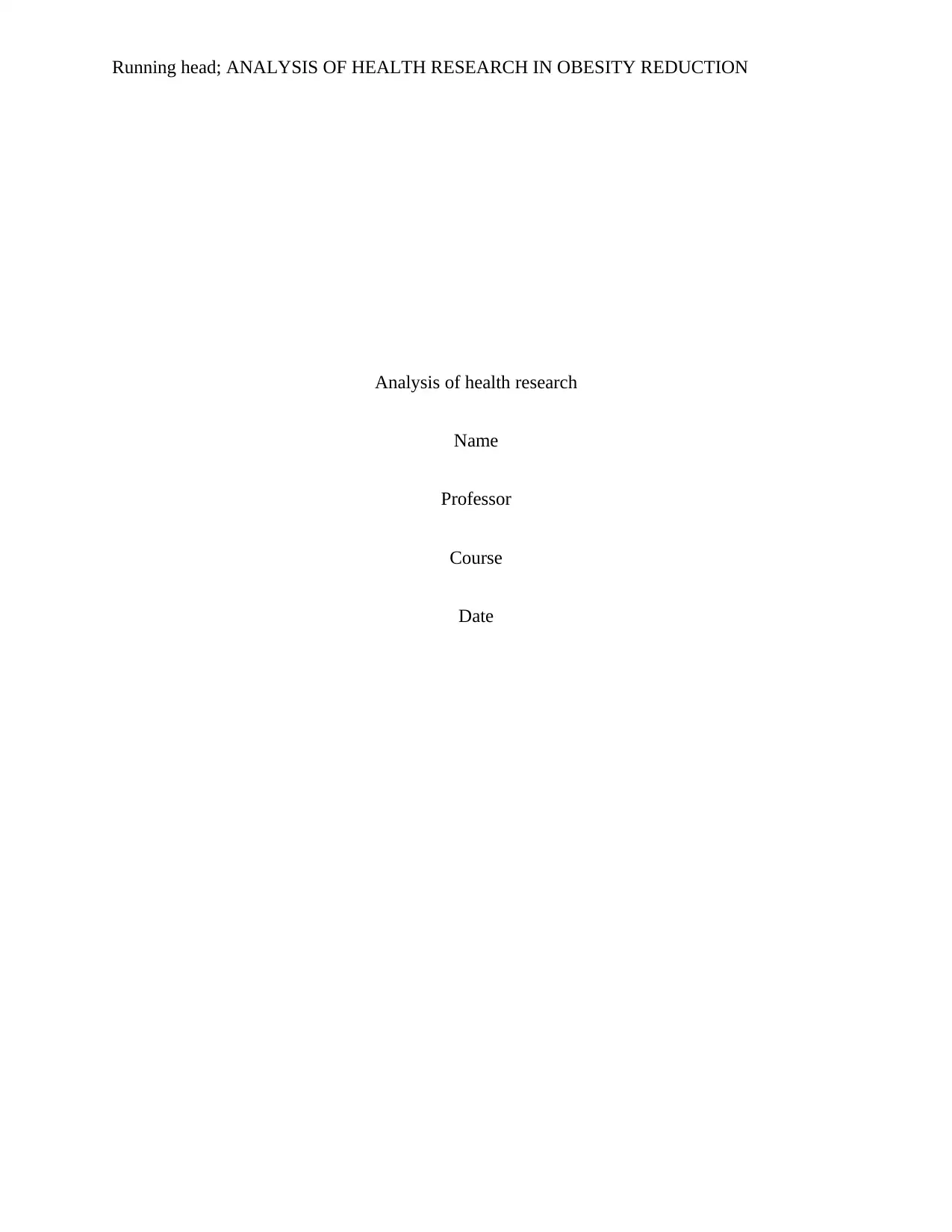
Running head; ANALYSIS OF HEALTH RESEARCH IN OBESITY REDUCTION
Analysis of health research
Name
Professor
Course
Date
Analysis of health research
Name
Professor
Course
Date
Paraphrase This Document
Need a fresh take? Get an instant paraphrase of this document with our AI Paraphraser
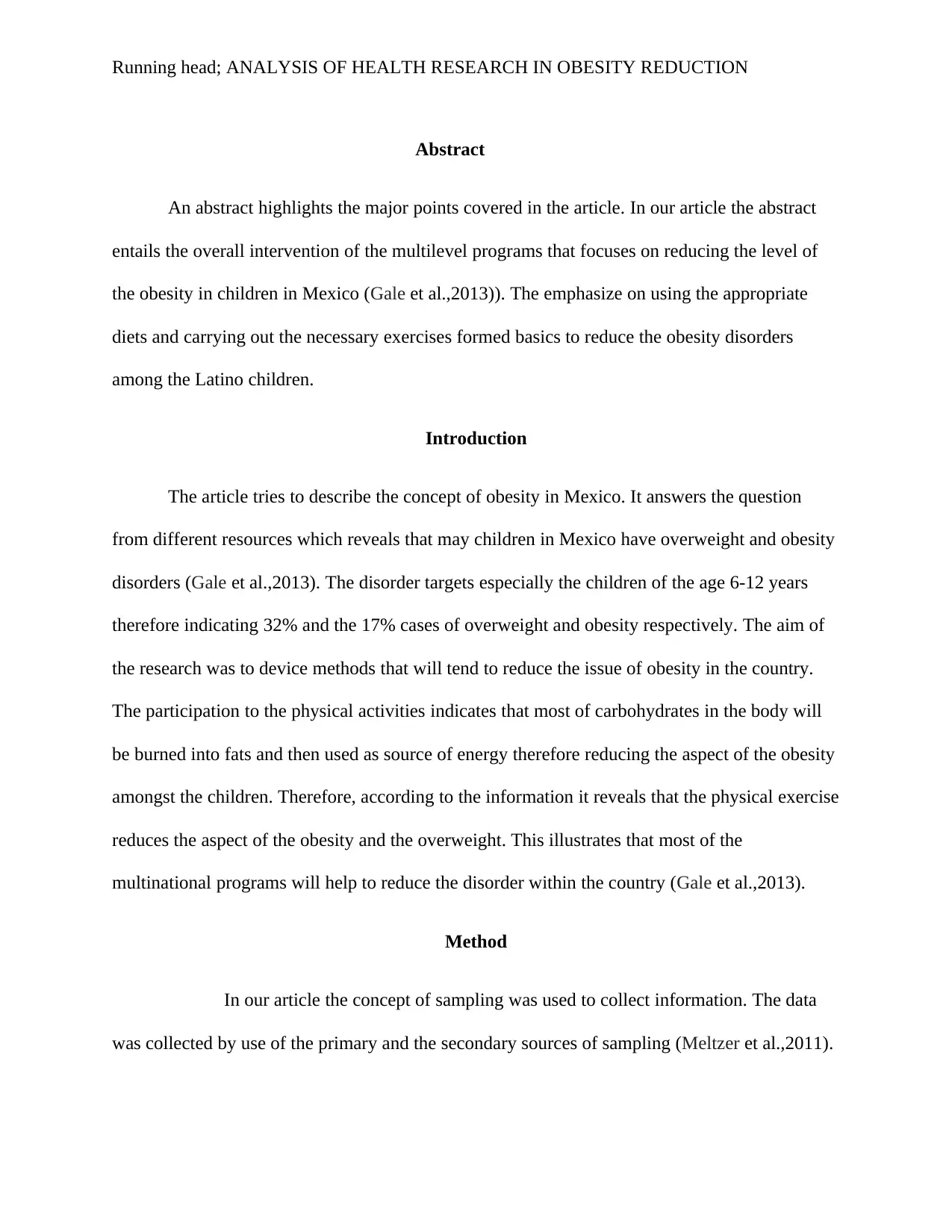
Running head; ANALYSIS OF HEALTH RESEARCH IN OBESITY REDUCTION
Abstract
An abstract highlights the major points covered in the article. In our article the abstract
entails the overall intervention of the multilevel programs that focuses on reducing the level of
the obesity in children in Mexico (Gale et al.,2013)). The emphasize on using the appropriate
diets and carrying out the necessary exercises formed basics to reduce the obesity disorders
among the Latino children.
Introduction
The article tries to describe the concept of obesity in Mexico. It answers the question
from different resources which reveals that may children in Mexico have overweight and obesity
disorders (Gale et al.,2013). The disorder targets especially the children of the age 6-12 years
therefore indicating 32% and the 17% cases of overweight and obesity respectively. The aim of
the research was to device methods that will tend to reduce the issue of obesity in the country.
The participation to the physical activities indicates that most of carbohydrates in the body will
be burned into fats and then used as source of energy therefore reducing the aspect of the obesity
amongst the children. Therefore, according to the information it reveals that the physical exercise
reduces the aspect of the obesity and the overweight. This illustrates that most of the
multinational programs will help to reduce the disorder within the country (Gale et al.,2013).
Method
In our article the concept of sampling was used to collect information. The data
was collected by use of the primary and the secondary sources of sampling (Meltzer et al.,2011).
Abstract
An abstract highlights the major points covered in the article. In our article the abstract
entails the overall intervention of the multilevel programs that focuses on reducing the level of
the obesity in children in Mexico (Gale et al.,2013)). The emphasize on using the appropriate
diets and carrying out the necessary exercises formed basics to reduce the obesity disorders
among the Latino children.
Introduction
The article tries to describe the concept of obesity in Mexico. It answers the question
from different resources which reveals that may children in Mexico have overweight and obesity
disorders (Gale et al.,2013). The disorder targets especially the children of the age 6-12 years
therefore indicating 32% and the 17% cases of overweight and obesity respectively. The aim of
the research was to device methods that will tend to reduce the issue of obesity in the country.
The participation to the physical activities indicates that most of carbohydrates in the body will
be burned into fats and then used as source of energy therefore reducing the aspect of the obesity
amongst the children. Therefore, according to the information it reveals that the physical exercise
reduces the aspect of the obesity and the overweight. This illustrates that most of the
multinational programs will help to reduce the disorder within the country (Gale et al.,2013).
Method
In our article the concept of sampling was used to collect information. The data
was collected by use of the primary and the secondary sources of sampling (Meltzer et al.,2011).
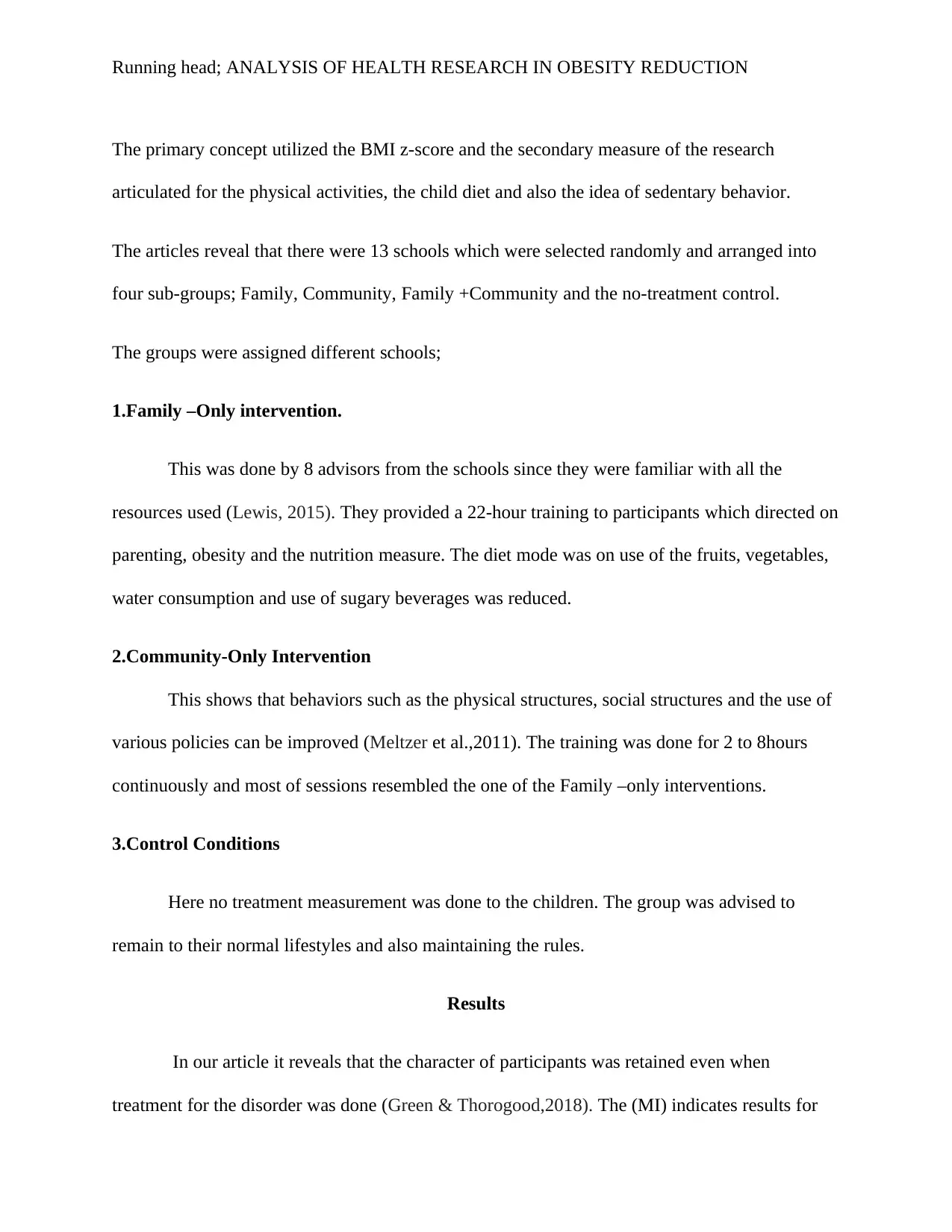
Running head; ANALYSIS OF HEALTH RESEARCH IN OBESITY REDUCTION
The primary concept utilized the BMI z-score and the secondary measure of the research
articulated for the physical activities, the child diet and also the idea of sedentary behavior.
The articles reveal that there were 13 schools which were selected randomly and arranged into
four sub-groups; Family, Community, Family +Community and the no-treatment control.
The groups were assigned different schools;
1.Family –Only intervention.
This was done by 8 advisors from the schools since they were familiar with all the
resources used (Lewis, 2015). They provided a 22-hour training to participants which directed on
parenting, obesity and the nutrition measure. The diet mode was on use of the fruits, vegetables,
water consumption and use of sugary beverages was reduced.
2.Community-Only Intervention
This shows that behaviors such as the physical structures, social structures and the use of
various policies can be improved (Meltzer et al.,2011). The training was done for 2 to 8hours
continuously and most of sessions resembled the one of the Family –only interventions.
3.Control Conditions
Here no treatment measurement was done to the children. The group was advised to
remain to their normal lifestyles and also maintaining the rules.
Results
In our article it reveals that the character of participants was retained even when
treatment for the disorder was done (Green & Thorogood,2018). The (MI) indicates results for
The primary concept utilized the BMI z-score and the secondary measure of the research
articulated for the physical activities, the child diet and also the idea of sedentary behavior.
The articles reveal that there were 13 schools which were selected randomly and arranged into
four sub-groups; Family, Community, Family +Community and the no-treatment control.
The groups were assigned different schools;
1.Family –Only intervention.
This was done by 8 advisors from the schools since they were familiar with all the
resources used (Lewis, 2015). They provided a 22-hour training to participants which directed on
parenting, obesity and the nutrition measure. The diet mode was on use of the fruits, vegetables,
water consumption and use of sugary beverages was reduced.
2.Community-Only Intervention
This shows that behaviors such as the physical structures, social structures and the use of
various policies can be improved (Meltzer et al.,2011). The training was done for 2 to 8hours
continuously and most of sessions resembled the one of the Family –only interventions.
3.Control Conditions
Here no treatment measurement was done to the children. The group was advised to
remain to their normal lifestyles and also maintaining the rules.
Results
In our article it reveals that the character of participants was retained even when
treatment for the disorder was done (Green & Thorogood,2018). The (MI) indicates results for
⊘ This is a preview!⊘
Do you want full access?
Subscribe today to unlock all pages.

Trusted by 1+ million students worldwide
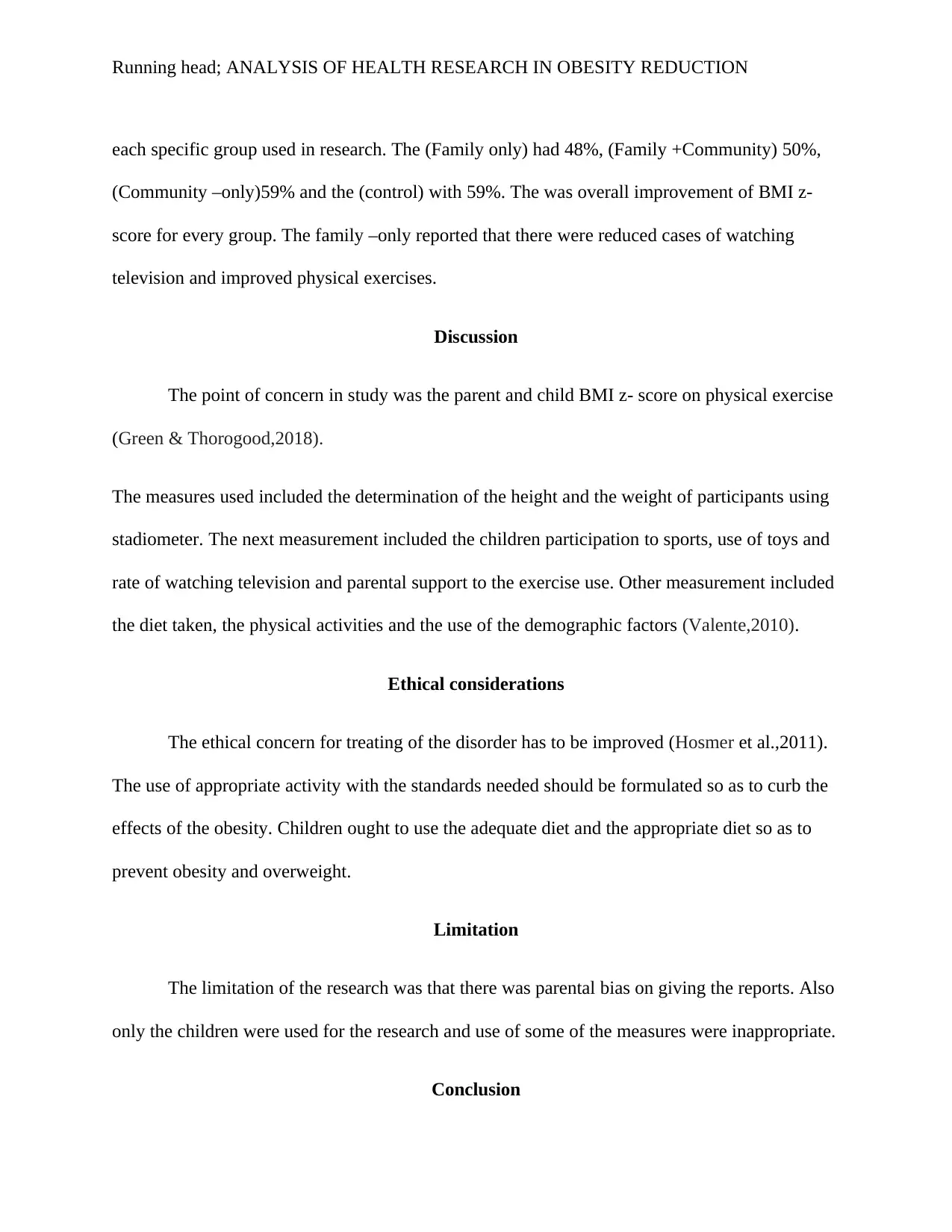
Running head; ANALYSIS OF HEALTH RESEARCH IN OBESITY REDUCTION
each specific group used in research. The (Family only) had 48%, (Family +Community) 50%,
(Community –only)59% and the (control) with 59%. The was overall improvement of BMI z-
score for every group. The family –only reported that there were reduced cases of watching
television and improved physical exercises.
Discussion
The point of concern in study was the parent and child BMI z- score on physical exercise
(Green & Thorogood,2018).
The measures used included the determination of the height and the weight of participants using
stadiometer. The next measurement included the children participation to sports, use of toys and
rate of watching television and parental support to the exercise use. Other measurement included
the diet taken, the physical activities and the use of the demographic factors (Valente,2010).
Ethical considerations
The ethical concern for treating of the disorder has to be improved (Hosmer et al.,2011).
The use of appropriate activity with the standards needed should be formulated so as to curb the
effects of the obesity. Children ought to use the adequate diet and the appropriate diet so as to
prevent obesity and overweight.
Limitation
The limitation of the research was that there was parental bias on giving the reports. Also
only the children were used for the research and use of some of the measures were inappropriate.
Conclusion
each specific group used in research. The (Family only) had 48%, (Family +Community) 50%,
(Community –only)59% and the (control) with 59%. The was overall improvement of BMI z-
score for every group. The family –only reported that there were reduced cases of watching
television and improved physical exercises.
Discussion
The point of concern in study was the parent and child BMI z- score on physical exercise
(Green & Thorogood,2018).
The measures used included the determination of the height and the weight of participants using
stadiometer. The next measurement included the children participation to sports, use of toys and
rate of watching television and parental support to the exercise use. Other measurement included
the diet taken, the physical activities and the use of the demographic factors (Valente,2010).
Ethical considerations
The ethical concern for treating of the disorder has to be improved (Hosmer et al.,2011).
The use of appropriate activity with the standards needed should be formulated so as to curb the
effects of the obesity. Children ought to use the adequate diet and the appropriate diet so as to
prevent obesity and overweight.
Limitation
The limitation of the research was that there was parental bias on giving the reports. Also
only the children were used for the research and use of some of the measures were inappropriate.
Conclusion
Paraphrase This Document
Need a fresh take? Get an instant paraphrase of this document with our AI Paraphraser
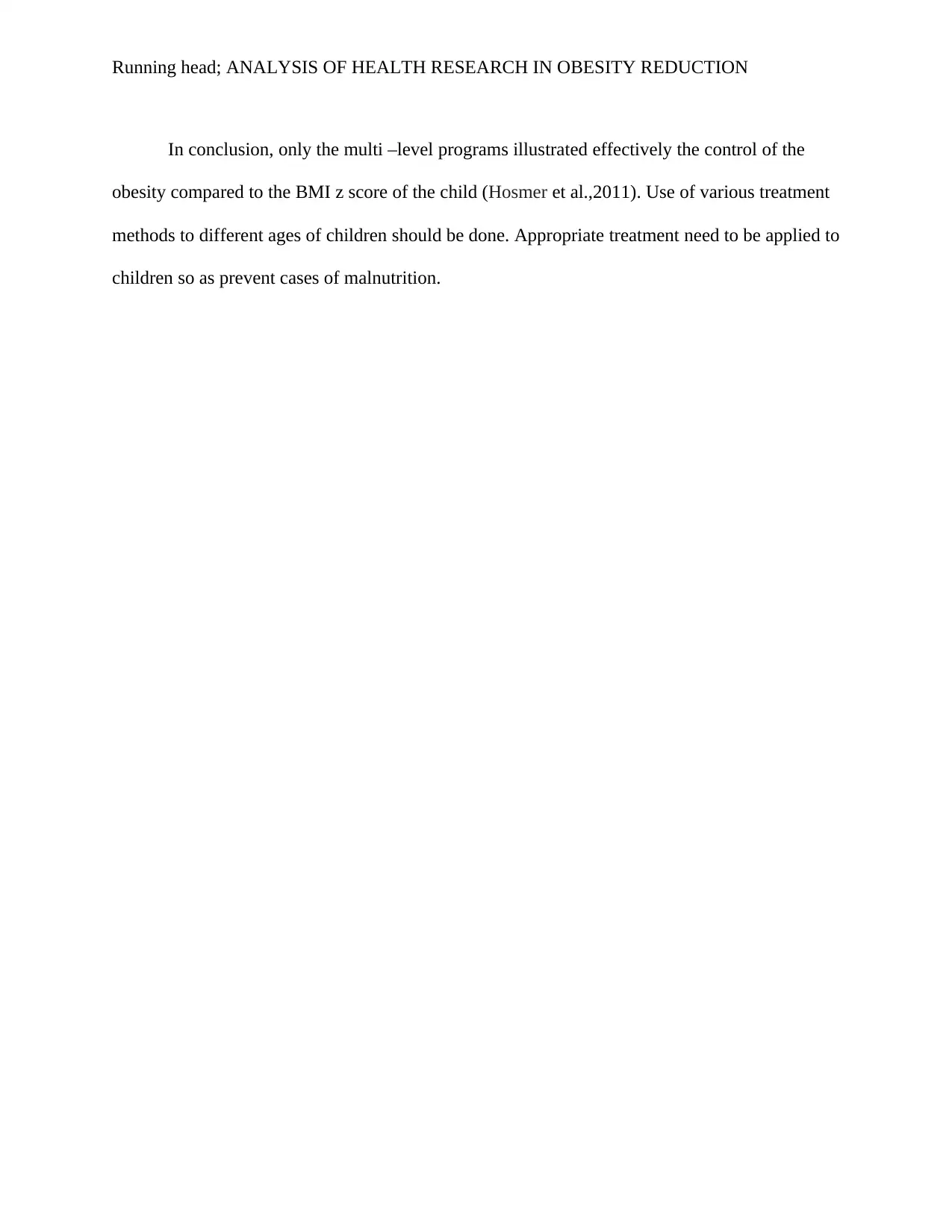
Running head; ANALYSIS OF HEALTH RESEARCH IN OBESITY REDUCTION
In conclusion, only the multi –level programs illustrated effectively the control of the
obesity compared to the BMI z score of the child (Hosmer et al.,2011). Use of various treatment
methods to different ages of children should be done. Appropriate treatment need to be applied to
children so as prevent cases of malnutrition.
In conclusion, only the multi –level programs illustrated effectively the control of the
obesity compared to the BMI z score of the child (Hosmer et al.,2011). Use of various treatment
methods to different ages of children should be done. Appropriate treatment need to be applied to
children so as prevent cases of malnutrition.
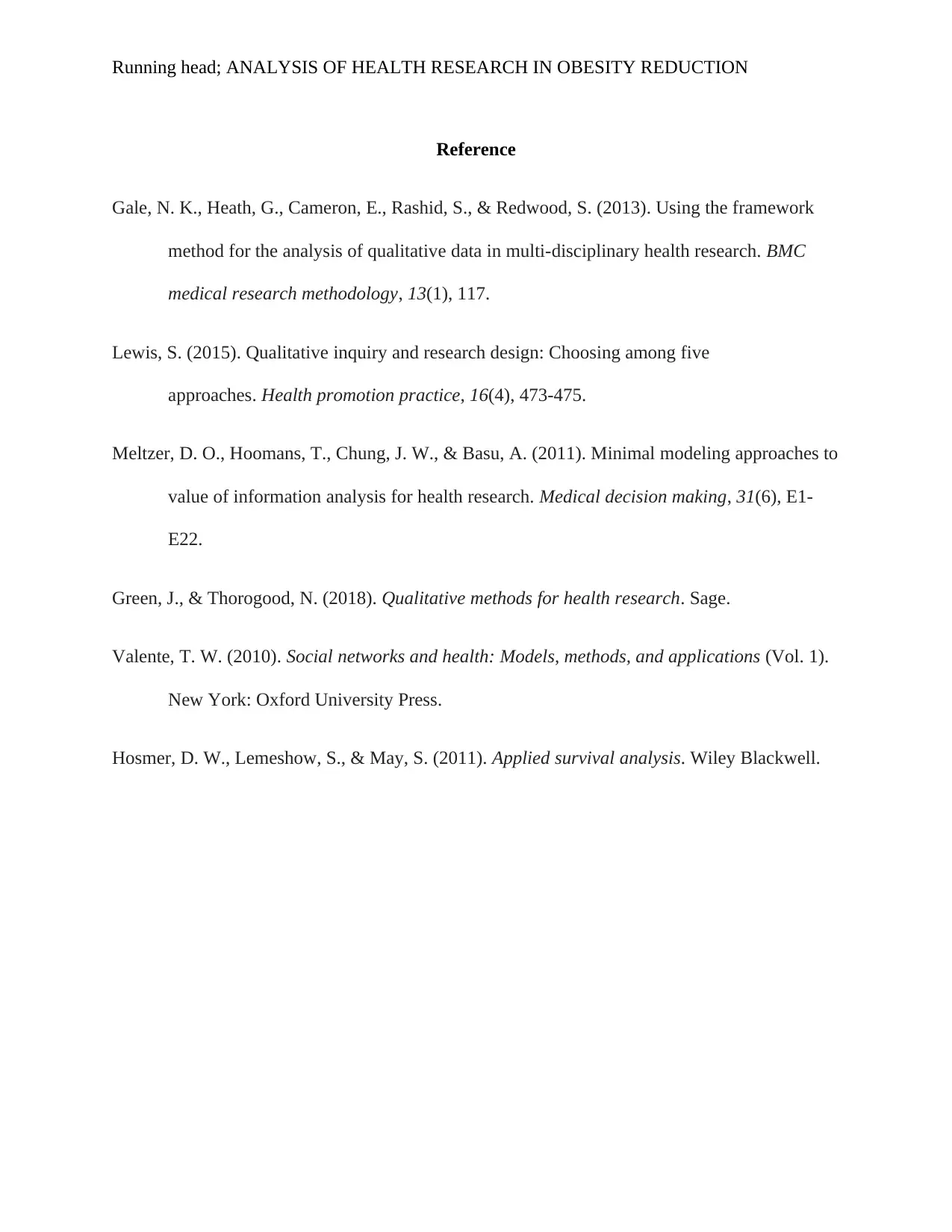
Running head; ANALYSIS OF HEALTH RESEARCH IN OBESITY REDUCTION
Reference
Gale, N. K., Heath, G., Cameron, E., Rashid, S., & Redwood, S. (2013). Using the framework
method for the analysis of qualitative data in multi-disciplinary health research. BMC
medical research methodology, 13(1), 117.
Lewis, S. (2015). Qualitative inquiry and research design: Choosing among five
approaches. Health promotion practice, 16(4), 473-475.
Meltzer, D. O., Hoomans, T., Chung, J. W., & Basu, A. (2011). Minimal modeling approaches to
value of information analysis for health research. Medical decision making, 31(6), E1-
E22.
Green, J., & Thorogood, N. (2018). Qualitative methods for health research. Sage.
Valente, T. W. (2010). Social networks and health: Models, methods, and applications (Vol. 1).
New York: Oxford University Press.
Hosmer, D. W., Lemeshow, S., & May, S. (2011). Applied survival analysis. Wiley Blackwell.
Reference
Gale, N. K., Heath, G., Cameron, E., Rashid, S., & Redwood, S. (2013). Using the framework
method for the analysis of qualitative data in multi-disciplinary health research. BMC
medical research methodology, 13(1), 117.
Lewis, S. (2015). Qualitative inquiry and research design: Choosing among five
approaches. Health promotion practice, 16(4), 473-475.
Meltzer, D. O., Hoomans, T., Chung, J. W., & Basu, A. (2011). Minimal modeling approaches to
value of information analysis for health research. Medical decision making, 31(6), E1-
E22.
Green, J., & Thorogood, N. (2018). Qualitative methods for health research. Sage.
Valente, T. W. (2010). Social networks and health: Models, methods, and applications (Vol. 1).
New York: Oxford University Press.
Hosmer, D. W., Lemeshow, S., & May, S. (2011). Applied survival analysis. Wiley Blackwell.
⊘ This is a preview!⊘
Do you want full access?
Subscribe today to unlock all pages.

Trusted by 1+ million students worldwide
1 out of 6
Related Documents
Your All-in-One AI-Powered Toolkit for Academic Success.
+13062052269
info@desklib.com
Available 24*7 on WhatsApp / Email
![[object Object]](/_next/static/media/star-bottom.7253800d.svg)
Unlock your academic potential
Copyright © 2020–2025 A2Z Services. All Rights Reserved. Developed and managed by ZUCOL.



